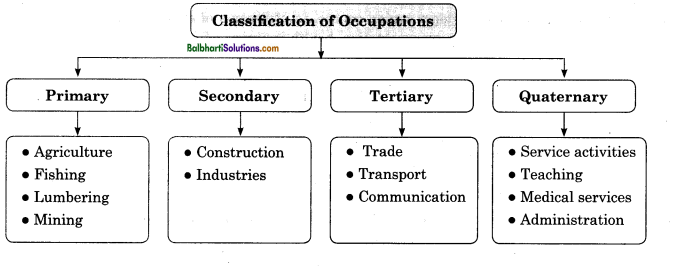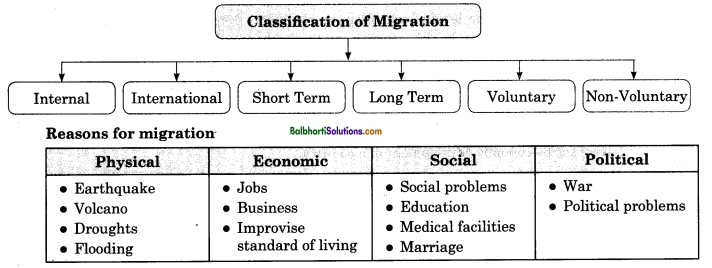By going through these Maharashtra State Board Class 12 Geography Notes Chapter 2 Population Part 2 students can recall all the concepts quickly.
Maharashtra State Board Class 12 Geography Notes Chapter 2 Population Part 2
→ The population is considered a human resource. Its physical and intellectual characteristics affect the development of any region/country.
→ Economic activities develop only with reference to human resources. In the absence of proper use of human resources, other resources are not developed effectively.
→ While studying population composition, we study, age structure, sex, literacy, education, and occupational structure.
Population Composition:
Age Structure
→ Age structure refers to the number of people in different age groups such as infants, children, teenagers, young, adult and old people.
→ Share of each age group in population varies from country to country.
→ Age structure of population can be studied with the help of population pyramid.
→ While drawing population pyramid, age group is taken on Y-axis in the centre and on X-axis population or percentage of population in different age group. On left side of graph is male population and right-side female population.
→ The base of the graph shows children population and apex shows old population.
→ Population in the age group 15-59 years indicate group of working population i.e., economically active population.
→ Population in the age group 0-15 years indicate dependent population or economically inactive population.
→ Population in the age group above 60 years, indicates greater expenditure on medical and health facilities since population in this age group is economically dependent.
![]()
Types of population pyramid
→ Expansive – Broad base with tapering top. This shows high birth rate and high death rates.
→ Constructive – This pyramid has narrower base and broader apex. It indicates lower percentages of younger population and more elderly population. It also shows lower birth rates and lower death rates.
→ Stationary – Population in almost all age groups is same. Very low birth and death rates. There is hardly any population growth.
Sex Composition:
→ Population pyramid gives us idea about number of men and women in different age groups.
→ The ratio between number of men and women in population is called sex ratio.
Sex Ratio = \(\frac{\text { Total Female Population }}{\text { Total Male Population }}\) ×1000
→ The sex ratio gives us important information about the status of women in a country.
→ Average sex ratio of the world population is 990 females per 1000 males.
→ Countries like Latvia, Estonia, Russia and Ukraine have the highest sex ratio in the world. (1162 females per 1000 males)
→ On the other hand, in Saudi Arabia, there are 667 females per 1000 males.
![]()
Demographic Dividend:
→ The growth in an economy as a result of a change in the age structure of a country’s population is known as Demographic Dividend.
→ The change in demographic dividend comes because of a decline in birth and death rates.
→ As birth rate decreases, the number of young dependent population decreases.
→ Economic productivity of a country depends upon the ratio between working and dependant (non-working) population.
→ Higher the ratio, higher is the contribution of working population in the economy.
→ With fewer people to support and more people working, economy’s resources are invested in other areas to accelerate a country’s economic development.
→ Per capita income increases.
→ Demographic dividend depends on the proper implementation of policies in the areas such as education, health, research, etc.
→ It also depends on the level of schooling, employment, frequency of childbearing, economic policy on tax incentives, health, pension, and retirement policies.
Literacy and Education
→ An important indicator of socio-economic development is the proportion of literate population of a country.
→ The standard of living, social status of females, education facilities, government policies reveal socio-economic development of a country.
→ Population above 7 years of age, who can read, write and have the ability to do simple arithmetic calculations with understanding is considered as a literate person in India.
![]()
Occupational Structure:
→ Population of men and women in the age group 15-59 years are considered as working population.
→ Working population take part in primary, secondary, tertiary and quaternary occupations.

Rural and Urban Composition:
→ On the basis of residence, population is divided into Rural and Urban.
→ Lifestyles of people living in rural and urban areas is different, which is based upon their livelihood and social conditions.
→ Age and sex composition, occupational structure, density and level of economic development are different in rural and urban areas.
→ The areas in which very large proportion of population engaged in primary occupations are considered as rural.
→ The areas in which large proportion and working population engaged other than primary occupations are considered as urban.
Migration:
→ Movement of people from one place to another, from one country to another, for lesser or longer period or permanently is called migration.
→ Migration also can be voluntary or non-voluntary.
→ Migration changes density patterns and structure of population in both donor as well as recipient region.

![]()
Impact of migration on population :
Donor region:
→ Out migration from donor region causes no utilization of existing facilities/services like housing, water supply, transportation, health facilities, education, recreation etc.
→ Expenditure incurred to develop these facilities goes to waste.
→ Age and sex structure changes tremendously. For example, in Kerala, sex ratio of 1,084 female per 1000 male population in working-age group.
Recipient regions
- Recipient region experiences tremendous pressure on the available facilities.
- In this region housing, water supply, transportation, medical, education facilities are becoming insufficient due to increasing population.
- Agricultural land is converted into non – agricultural activities, such as housing.
- Land prices increase tremendously. Lack of housing leads to the development of slums.
- There is a shortage of public services, increased economic inequality and crime rate.
- There will be unfavourable sex ratio e.g., Mumbai 832 and Pune 948.
- Working-age population higher than non-working age group population.